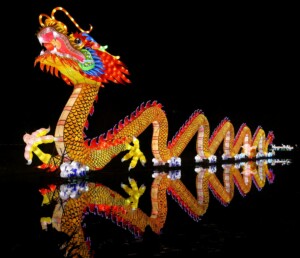
In Feng Shui terminology, the mountain dragon is also referred to as the “Sitting number” or “mountain star.” Likewise, the water dragon is also referred to as the “Facing number” or the “water star.” This is all code for the energy blueprint created in a house or building when it has been completed. I like to throw in the “dragon” part in order to make sure students are not confusing the elements associated with the flying stars.
For example, the 9 “fire” star is the Li fire Trigram. And yet, we can refer to the 9 star as a “water star” when it is in a certain position in the flying star chart. As well, we can refer to the 9 star (with its essential fire nature), as a mountain star, which implies “earth.” The “dragon” reference lets us know for that moment, we are concerned only with identifying the position of the star in the chart and whether that star is more likely to influence health and relationships (mountain dragon) or if it is more likely to affect money, career and “yang” type events (water dragon).
Why do the Chinese and Feng Shui practitioners specifically use this dragon imagery? Can’t tell you right now. That would be a whole other separate topic. Even the undulations on a hillside or literal mountain are referred to as “dragon veins.” There is some hefty symbolism here in regards to the dragon’s veins, breath or dragon’s lair as far as Qi (air currents and life force energy) are concerned.
With this concept of Mountain Dragon and Water Dragon, there are various ways, from different schools, in how to enhance them or control them. Or, as the saying goes, “There is more than one way to slay a dragon.” The Mountain Dragons and Water Dragons Case Study catalogues the different ways to interpret and handle these energies.
EXCERPT:
“When it comes to the Wang Star, also known as the Prominent Qi or Noble Qi, we can say that the wang star is “above the law.” The wang star may be treated differently than the other stars which are not timely.
Now, coming up later in this Case Study will be some expanded examples of what qualifies as a mountain or as water when we want to use these techniques.
If a mountain dragon is timely, we can place a mountain near it to enhance it further.
If a mountain dragon is un-timely, we can “put it in water” to dis-empower it. To continue with a metaphor, this might be like throwing a land animal in the water, where it may actually drown. Water is not the mountain dragon’s natural environment. It may not be able to swim.
If a water dragon is timely we can provide it with water to make it even happier.
If a water dragon is untimely, we can “put it on a mountain” to disable it. This might be like taking a fish out of the water and tossing it up onto the shore, or on a mountain. It won’t survive long.
In evaluating any flying star, we can now consider whether it is timely or untimely first and foremost.
Then we evaluate how a mountain dragon or water dragon may behave in the environment, based on all the other influences of form and use.
An example of “form” might be the literal volume of furnishings in the room, the exposure to light and all aspects which can contribute to the room being more yin or yang. An example of “use” might be whether the room is used for sleeping or studying or entertaining.
Then we can provide an appropriate mountain or water adjustment IN ADDITION to looking at the Five Element Theory approach.”
Author: Kartar Diamond
Company: Feng Shui Solutions (R)
From the Feng Shui Theory Blog Series

Leave A Comment
You must be logged in to post a comment.